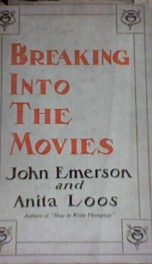breaking into the movies

Purchase of this book includes free trial access to www.million-books.com where you can read more than a million books for free. This is an OCR edition with typos. Excerpt from book: CHAPTER III ACTING FOR THE SCREEN In New York resides a dramatic critic, now on the staff of a great newspaper, who has his own ideas about movie acting. The idea in question is that there is no such thing as movie actingand the gentleman carries it out by refusing to allow the word "acting" to be printed in any of the notices and reviews in his newspaper. When he wishes to convey the thought that such and such a star acted in such and such a picture he says, "Miss So-and-So posed before the camera in the motion picture." Now this critic is a good critic, as critics go, but he would be improved physically and mentally by a set of those monkey glands which the medicos are so successfully grafting upon various ossified personalities. Anyone who thinks that there is no such thing as motion picture acting is probably still wondering whether the Germans will win the war. Motion picture acting is a highly developed art, with a technique quite as involved as that of the legitimate stage. The fundamental principle to remember in undertaking screen acting is that the camera demands far greater realism on the part of the actor than the eyes of an audience. An actor in the spoken drama nearly always overplays or underplays his part. If he recited the same lines in the same tone with the same gesturesin real life, he would appear to be just a little bit spiffy, as they say in English drinking circles. On the stage it is necessary to overdraw the character in order to convey a realistic impression to the audience; exact naturalism on the stage would appear as unreal as an unrouged face under a spotlight. The camera, however, demands absolute realism. Actors must act as naturally and as leisurely as they would in their own homes. Their expressions must be no more pronounced than...
Info about the book
Author:
Series:
Unknown
ISBN:
0802426433
Rating:
5/5 (4)Your rating:
0/5
Languge:
English
Users who have this book
Users who want this book
What readers are saying
What do you think? Write your own comment on this book!
write a commentGenre
if you like breaking into the movies try:
Other books by this author
Do you want to read a book that interests you? It’s EASY!
Create an account and send a request for reading to other users on the Webpage of the book!

